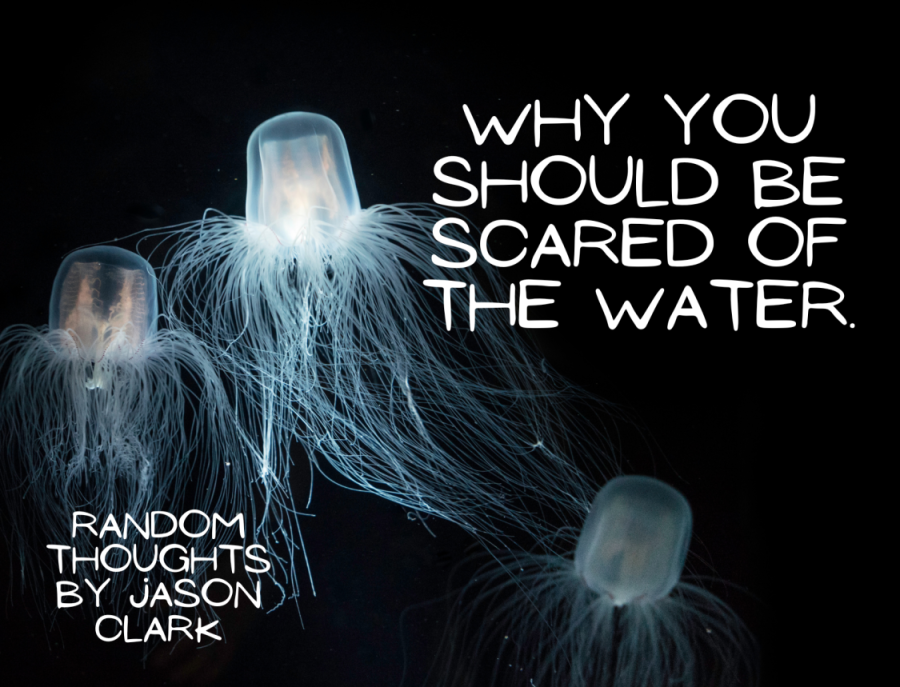Things in the ocean that make me never want to swim again
Please keep them away from me
photo or infographic by Jason Clark on Canva
GET IT AWAY FROM ME. The box jellyfish, a creature on my reverse bucket list (things I never want to do).
In Mr. Manning’s aquatic science class, a series of animal dissections have brought to the school’s attention the wonders and beauty of the ocean. These and many more organisms are essential to the health of our seas and contribute something, whether it be big or small, to the greater good of our world. Unfortunately, a lot of these creatures freak me out. A lot.
So, in order to make light of the nightmares of the deep, I have embarked on a slimy, scaly, and sometimes scary dive into the worst sea creatures I could get my hands on. These are not on this list because they are the most dangerous or deadly animals in the ocean (though #4 very well could be), but instead are here because they make me really uncomfortable.
Sea Lamprey (Petromyzon marinus)
Starting off the list is the eel-like sea lamprey, also known as the “vampire fish.” This horrible little fish (and it is a fish regardless of its strange body) is a parasite that feeds off the blood and bodily fluids of the other inhabitants of its environment. Using their sucker-shaped mouth and sharp tongue, lampreys latch onto their prey and drain its blood until either the lamprey is full or the fish dies, though the death of the host is usually rare. A small silver lining is that for the most part, lampreys do not attack humans and generally stay away (which is how I would like it to stay, thank you).
Australian Box Jellyfish (Chironex Fleckeri)
Outwardly, the Australian box jellyfish seems to just be an ordinary jellyfish: able to deliver a nasty sting that fades overtime. This is not the case for any poor swimmer stung by this reaper of the deep. This jellyfish has been given the rather threatening title of “most lethal jellyfish in the world” and lives up to its name. Using the stinging cells on its tentacles, the box jellyfish injects an extremely powerful venom into the victim’s body, causing severe pain. If the sting area is large enough and in a vital place, the victim can die in two to five minutes. Yikes. They also are able to swim and have eyes so they can chase you which is just horrible.
Cookiecutter Shark (Isistius brasiliensis)
Unlike the previous entry on this list, the cookiecutter shark is not deadly. In fact, there has not been one human fatality caused by this little shark and due to its habitat offshore it rarely interacts with people. There are two reasons this little guy is on this list: The first reason is because the feeding habits of this shark are unnerving at best. Using its lips to stick itself to its target, the cookiecutter shark cuts a deep and circular hole in the flesh of its prey (usually large fish and whales), leaving a cavity not unlike the ones left in dough by cookie cutters. The second reason is that, while rare, these sharks do occasionally attack swimmers who swim over deep water. Swimmer Eric Shall was bitten on March 31, 2019 and was left with a laceration on his stomach. I don’t think I can link photos of it because of school policy, but for readers with strong stomachs be warned: the cookiecutter’s bite is a truly nasty sight.
Tongue-eating Louse (Cymothoa exigua)
Oftentimes, the name of a creature tells you nothing about it and leaves you guessing as to what it does, how it acts, and what it looks like. The tongue-eating louse is not one of those creatures, since it does, acts, and looks exactly how it sounds. An isopod (think roly-polys), this parasitic animal lives in the sea and feeds on fish in one of the worst ways I’ve ever heard of. The louse enters the fish’s mouth and eats its tongue, then anchors itself to the muscles that once controlled it, essentially replacing the fish’s tongue with itself. This doesn’t kill the fish who now has to share food with the bug in its mouth. A horrific hallmark of the tongue-eating louse is that it is the only parasite that “replaces” an organ of the host and takes over the functions that the now eaten tongue used to do. Though it doesn’t prey on humans and is overall not dangerous in any way, I still want it to stay as far away from me as possible and maybe leave the fish alone and get a real job instead of being a tongue. There are better professions out there.
The Bobbit Worm (Eunice aphroditois)
I don’t believe any species should go extinct. Every living thing on this planet we share has a right to live and should never be purged from this world for the sole crime of existing. However if at gunpoint I was forced to choose, the bobbit worm would be the animal I would lose the least sleep over. The crowned champion of this list and frequent visitor of my nightmares, the bobbit worm serves as a wonderful argument that there is no God since why would a kind and benevolent creator make such a thing. Let me lay out the exact reasons I actually hate this thing (and not a joking kind of hate for the purpose of this article either. I actually despise the bobbit worm as a concept). Firstly, the bobbit worm is an ambush predator that buries itself in the sand and waits for prey to trigger its feeler antennae. It then uses its razor sharp mandibles to grab prey with such strength it can snap some fish in half. After brutally stunning its prey, it drags the still living creature into the sand to devour it piece by piece. Also, its body is really unnerving. Being a relative of the earthworm, one might think that the bobbit worm is rather small. This is not true. At all. The bobbit worm can instead reach lengths of nine feet, which is the worst. This thing makes me want to never want to swim again and frankly, the only reason I still do is because if I stop, I’m letting the bobbit worm win. I will never let the bobbit worm win. Never.
Thankfully for the students of Mr. Manning’s class, they have not had to encounter these denizens of the deep and I personally hope they never do. The lessons they have gained from the dissections of the perfectly normal and not-horrible animals they have been provided with have enabled them to gain a sense of how the bodies of water-dwelling creatures work and therefore have allowed them to see just a little more of how the grand mechanisms of our oceans work.
Your donation will support the student journalists of Willis High School. Your contribution will allow us to purchase equipment and cover our annual website hosting costs.












heidi • May 1, 2023 at 8:07 AM
i never thought i would be scared of a worm. until now.